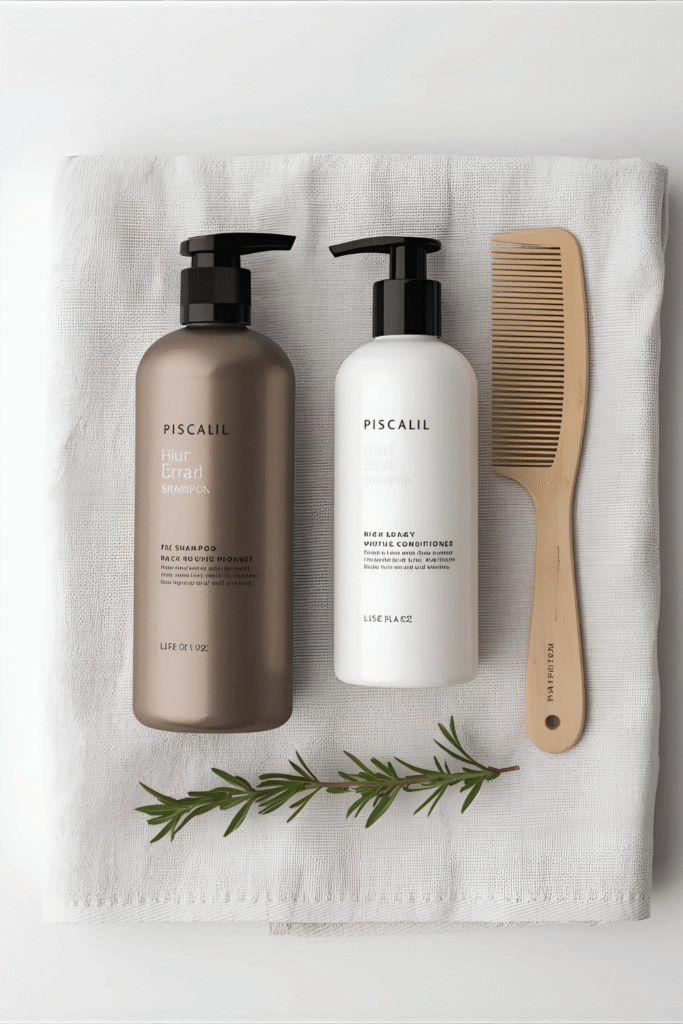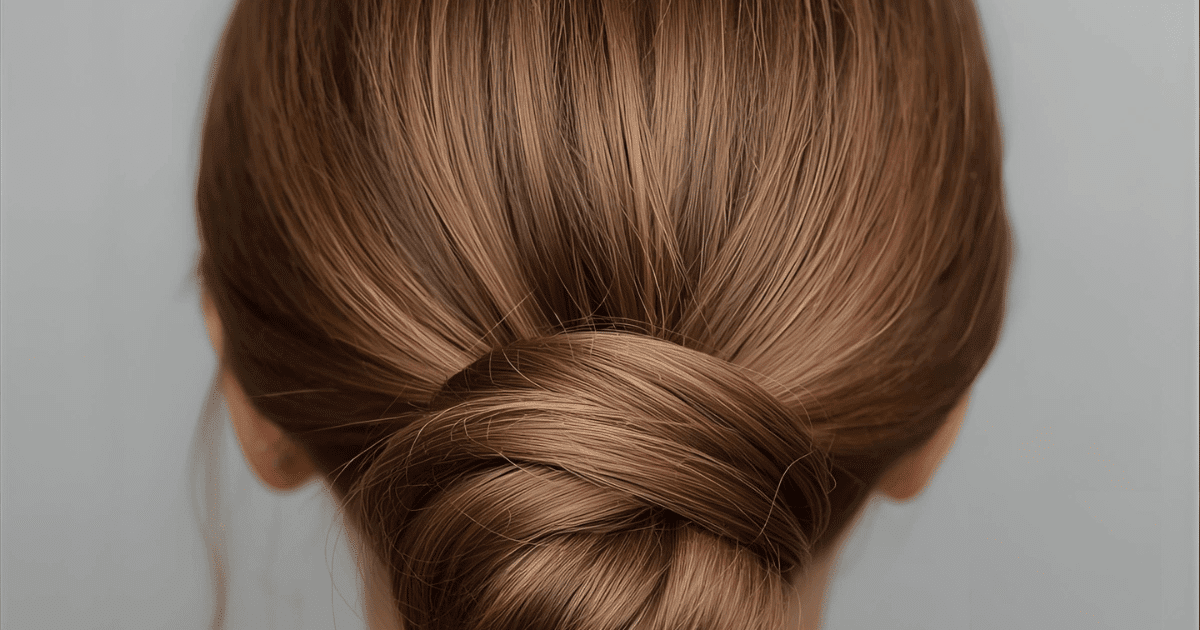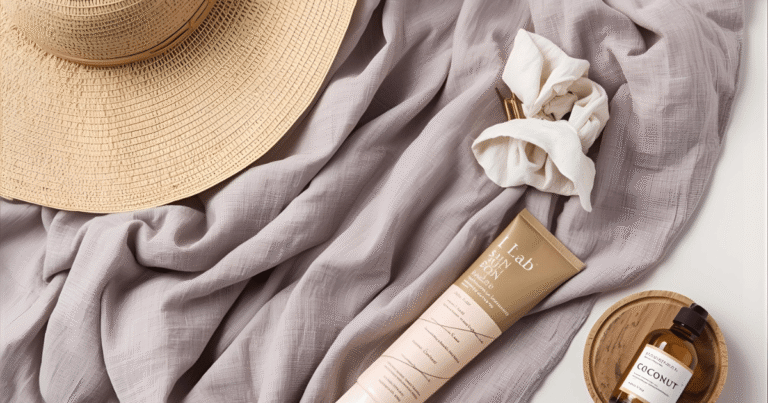Thick Hair Care: Simple Tips for Styling and Managing Beautiful Volume
My eldest daughter was born with a moderate head of hair, nothing to take note of. Her newborn photos show this tiny face framed with average newborn whisps, but once it started growing, it quickly became thick and long.
Twenty-six years later, that hair has only gotten thicker.
If you’re the mother of a thick-haired daughter (or you’re blessed with abundant locks yourself), you know exactly what I mean. You know the snap of the third hair tie giving up mid-ponytail. You know the forty-five minutes it takes to blow dry. You know the particular exhaustion that comes from holding your arms above your head trying to wrestle all that hair into a bun that will actually stay put through a single church service.
And yet. There’s a reason thick hair has been prized throughout history. When it cooperates, thick hair is absolutely stunning. It holds styles beautifully. It photographs like a dream. It makes a simple ponytail look intentional and elegant rather than thrown-together.
The key word, of course, is “cooperates.”
After years of trial and error with my daughter’s mane (and consulting with a wonderful stylist, who specializes in thick and textured hair), I’ve learned that getting thick hair to cooperate isn’t about fighting against it. It’s about understanding what thick hair actually needs and working with its natural tendencies rather than against them.
This guide is everything I wish someone had handed me when my daughter’s hair started getting long enough to require real management. Whether you’re caring for a daughter’s thick locks or your own, these are the strategies that actually work.

Understanding Thick Hair: Why It’s Different
Before we dive into care and styling, let’s talk about what makes thick hair unique. Understanding the “why” behind thick hair’s behavior helps everything else make sense.
Thickness vs. Density: They’re Not the Same
When we talk about “thick hair,” we might actually mean two different things. Thickness refers to the width of individual hair strands. Density refers to how many strands you have per square inch of scalp. Many people with “thick hair” actually have both: wide individual strands AND a lot of them.
This matters because thick strands behave differently than fine strands. They’re stronger and more resilient, which sounds like good news (and it is), but they’re also more prone to dryness because the natural oils from your scalp have more surface area to cover before they reach the ends.
The Weight Factor
Thick hair is heavy. A full head of thick, long hair can weigh several ounces, which doesn’t sound like much until you realize that weight is constantly pulling on your roots, your hair ties, and your bobby pins. This is why standard elastic bands snap, why updos slide down, and why your arms ache after styling.
The Drying Time Problem
All that hair takes a long time to get wet and even longer to dry. This isn’t just an inconvenience; it affects everything from your morning routine to the health of your hair. Hair that stays damp for extended periods can develop issues, and the temptation to use high heat to speed drying can cause damage.
The Product Absorption Reality
Thick hair absorbs products differently than fine hair. It can drink up a conditioning mask like a sponge, which is wonderful, but it can also trap product residue more easily, leading to buildup that weighs hair down and makes it look dull.
Understanding these characteristics helps explain why thick hair needs its own approach to care and styling. What works beautifully for your fine-haired daughter may be completely wrong for those with thick hair.
The Thick Hair Care Routine: Getting the Foundation Right
Healthy thick hair starts with proper care. Get this foundation right, and everything else becomes easier.
Washing: Less Often, More Thoroughly
Here’s something that might surprise you: thick hair generally shouldn’t be washed every day. In fact, washing every three to five days is often ideal.
Why? Thick hair tends toward dryness. Each strand has more surface area than a fine hair strand, which means natural scalp oils must travel farther to reach the ends. When you wash daily, you strip away those oils before they have a chance to do their moisturizing work.
The result of over-washing is a frustrating cycle: dry ends, an overcompensating oily scalp, and hair that somehow looks both greasy at the roots and straw-like at the tips.
The Right Way to Wash Thick Hair
When you do wash, technique matters enormously. Here’s the method that works:
First, get your hair thoroughly wet. This takes longer than you think. Let water run over your head for at least a full minute, working your fingers through to ensure every layer is saturated. Thick hair has a lot of “underneath,” and if those inner layers aren’t wet, shampoo won’t reach them properly.
Second, focus shampoo on your scalp, not your lengths. Your scalp is where oil and buildup accumulate. The ends of your hair don’t need direct shampooing; the suds that rinse down will clean them adequately.
Third, use your fingertips (never your nails) to massage your scalp thoroughly. Work in sections if needed. With thick hair, it’s easy to clean only the surface while the hair underneath remains unwashed. Lift sections and make sure you’re reaching the scalp all around your head, including the often-neglected nape of your neck.
Fourth, consider double-cleansing. The first shampoo removes surface oil and product buildup. The second shampoo actually delivers the benefits of whatever specialty shampoo you’ve chosen (moisturizing, volumizing, color-protecting). You’ll notice the second wash produces much more lather.
Fifth, rinse completely. Leftover shampoo residue is a primary cause of dull, heavy-feeling thick hair. Take your time here. Lift sections and rinse underneath.
Between-Wash Refreshing
For those days between washes, dry shampoo is your best friend. A light application at the roots absorbs excess oil and adds volume back to hair that’s starting to look flat. (If you’d like to make your own natural version, we have a recipe for DIY dry shampoo that works beautifully for all hair colors.)
You can also simply rinse your hair with water on non-wash days if it feels sweaty or needs refreshing. A water-only rinse removes surface sweat without stripping away the beneficial natural oils.
Conditioning: Essential but Strategic
Thick hair craves moisture, but conditioner must be applied strategically or it backfires.
Where to Apply
Conditioner belongs on your mid-lengths and ends only. Applying conditioner to your scalp weighs hair down at the roots and can leave even freshly washed hair looking flat and greasy. Start applying about ear-level and work down to your ends, where moisture is needed most.
How Long to Leave It
Follow your conditioner’s instructions for timing, but know that thick hair can generally benefit from a bit longer than the minimum. The extra time allows product to penetrate those thicker strands.
Choosing the Right Formula
This is where knowing your hair matters. Thick hair that’s also coarse and dry needs rich, moisturizing conditioners. Thick hair that’s fine-stranded but dense might get weighed down by heavy formulas and do better with lightweight options. Pay attention to how your hair responds and adjust accordingly.
Deep Conditioning Treatments
Because thick hair tends toward dryness, especially at the ends, a weekly deep conditioning mask can be transformative. Apply to damp hair, focusing on ends, and leave on for the recommended time (or longer, if your hair is particularly thirsty). The difference in softness and manageability is remarkable.
Drying: Patience and Protection
The drying process is where many thick-haired women unknowingly damage their hair. Here’s how to do it right.
Air Drying: The Healthiest Option
Whenever possible, let your hair air dry at least 80% before introducing any heat. Yes, this takes time. Plan accordingly. Wash your hair in the evening if morning drying isn’t practical, or on days when you can let it dry naturally.
Towel Techniques
Never rub thick hair vigorously with a towel. This causes friction damage, tangles, and frizz. Instead, gently squeeze excess water out, then wrap hair in a microfiber towel or even a soft cotton t-shirt. These materials are gentler than terrycloth and absorb water effectively.
Blow Drying Smart
When you do need to blow dry, use a heat protectant spray first. Start with your dryer on a medium heat setting; you don’t need the highest heat to dry thick hair, just patience. Dry in sections, lifting hair to reach the underlayers. Finish with a cool shot to seal the cuticle and add shine.
Nighttime Protection
What happens while you sleep significantly impacts your hair’s health and appearance. Two simple changes make a tremendous difference:
Sleep on Silk
Switching from a cotton pillowcase to silk or satin is one of the best investments you can make for thick hair. Cotton creates friction as you move during sleep, leading to tangles, frizz, and breakage. Silk allows hair to glide smoothly, reducing friction damage and helping hair retain moisture. Research confirms that silk’s smooth surface can reduce hair friction by up to 43%, and the difference is noticeable within days of making the switch.
As a bonus, silk pillowcases help preserve your style. Hair that would be a tangled mess on cotton often looks remarkably intact on silk.
Loose Protective Styles
Consider how you secure your hair for sleep. A loose braid or a low, soft bun keeps hair contained without the tension of tight elastics. Alternatively, some women prefer to simply let their hair down on the silk pillowcase. Experiment to find what works best for your hair’s length and texture.

Styling Thick Hair: Working With What You Have
Now that we’ve covered care, let’s talk about styling. The good news about thick hair? It holds styles beautifully. The challenge? Getting it into those styles in the first place.
The Essential Tools for Thick Hair
Before we discuss specific styles, let’s talk tools. The right tools make styling thick hair infinitely easier.
Quality Hair Ties
Standard drug-store elastics are your enemy. They snap, they slide, and they damage your hair. Invest in hair ties specifically designed for thick hair. Spiral coil ties (the telephone cord style) grip well without creating creases. Fabric-covered elastics in larger sizes provide hold without breakage. For serious hold that lasts all day, look for snag-free elastics designed for thick or curly hair.
Bobby Pins That Actually Work
Not all bobby pins are created equal. For thick hair, you need bobby pins with strong tension and a textured surface that grips. Insert them wavy-side down for maximum hold, and use more than you think you need. Where fine hair might need two bobby pins, thick hair might need six.
The Right Brush
A quality detangling brush makes a significant difference in managing thick hair. Wide-tooth combs and paddle brushes with flexible bristles work through thick hair without causing breakage. Never brush thick hair when it’s fully wet; this is when hair is weakest. Instead, use a wide-tooth comb on damp hair with conditioner still in it, or wait until hair is at least partially dry.
Quality Clips
A large claw clip is a thick-haired woman’s secret weapon. Choose one sized appropriately for your hair’s volume. The clip should close securely without straining like these pretty clips. A good claw clip can hold your hair up for everything from washing your face to grocery shopping.

Styles That Work for Thick Hair
These styles use thick hair’s weight and volume as advantages rather than fighting against them.
The Low Ponytail: Sleek and Secure
A low ponytail positioned at the nape of the neck is classic for good reason. The low position means gravity works with you rather than against you. For a polished look, smooth hair back with a lightweight styling cream, secure with a quality elastic, and wrap a small section of hair around the elastic to conceal it, pinning underneath.
To elevate this simple style, add a beautiful accessory. A silk scrunchie, a ribbon, or an elegant hair clip transforms a basic ponytail into something intentional and put-together.
The Classic Braid
Braids and thick hair were made for each other. A thick braid has presence and beauty that a thinner braid simply can’t match. French braids, Dutch braids, simple three-strand braids, or fishtails all look stunning with thick hair and stay secure throughout the day.
The key to braiding thick hair is working in smaller sections than you might think necessary. This gives you more control and creates a more defined finished braid.
The Low Bun: Elegant and Practical
A low bun is perhaps the most versatile updo for thick hair. It’s appropriate for everything from church to weddings to a day of errands when you simply need hair out of your face.
Here’s the method that works: Start with a low ponytail secured with a strong elastic. Twist the length of the ponytail into a rope, then wrap it around the base, tucking the end underneath. Secure with bobby pins inserted at angles around the bun. For extra security with very thick hair, use a hairnet in your hair color over the bun before pinning; this gives bobby pins something to grip.
The French Twist: Timeless Sophistication
The French twist is a beautiful option for thick hair because the hair’s volume creates a substantial, elegant roll. It does require practice, but once mastered, it’s a go-to style that looks far more complicated than it is.
The secret for thick hair? Don’t try to capture all your hair at once. Work in sections, building the twist gradually and securing as you go.
Half-Up Styles: The Best of Both
Half-up styles let you show off your hair’s volume while keeping it controlled. Pull the top section back (everything above your ears), secure with a clip or elastic, and leave the rest down. This works beautifully for thick hair because the bottom half still hangs down where it falls naturally, while the top is controlled.
Vary this basic style by twisting the top sections before securing, adding braids, or using decorative clips and accessories.

The Role of Accessories
For those of us managing thick hair, the right accessories aren’t optional; they’re essential.
Oversized Scrunchies
A standard scrunchie disappears into thick hair. Oversized scrunchies provide the volume needed to actually be seen and the gentle hold that won’t damage hair. Plus, they’re wonderfully comfortable since they don’t pull or create those ponytail headaches that tight elastics cause.
Hair Sticks and Forks
These traditional accessories work remarkably well for thick hair. A simple twist secured with a hair stick can hold all day. Look for sticks that are sturdy (not decorative flimsy ones) and long enough to accommodate your hair’s volume.
Claw Clips
We mentioned these earlier, but they deserve emphasis. A quality claw clip can create an instant updo that looks intentional while taking approximately five seconds to achieve. Look for clips with strong springs and sturdy construction.
Bun Covers and Snoods
These vintage-inspired accessories are having a well-deserved comeback, and they’re particularly wonderful for thick hair. A bun cover transforms a messy bun into an elegant style instantly, and it provides extra security since all that hair is contained within the cover’s structure.
Common Thick Hair Struggles (and Solutions)
Let’s address the specific frustrations thick-haired women face.
“My updos fall out within an hour.”
This is usually a tool problem, a technique problem, or both.
On the tool side: standard bobby pins and regular hair ties aren’t strong enough. Upgrade to professional-grade bobby pins and elastics designed for thick hair.
On the technique side: try anchoring your updos more securely. Use more pins than you think you need. Cross bobby pins in an X pattern for extra grip. Consider using a small clear elastic to create an anchor point before building your updo.
Also consider the style itself. Some updos that work beautifully on fine hair simply aren’t designed to handle the weight of thick hair. Stick with styles that work with gravity (low buns, low ponytails) or that distribute weight evenly.
“My hair takes forever to dry.”
This is the reality of thick hair. You can minimize drying time somewhat with these strategies:
Apply a microfiber towel immediately after washing to absorb excess water. Scrunch gently rather than rubbing.
If blow drying, work in sections and use the concentrator attachment to direct airflow efficiently.
Wash your hair in the evening when you have time to let it air dry partially before bed.
Accept that some hairstyles (like air-dried natural waves) might require planning your wash day around your schedule.
“My hair looks greasy at the roots but dry at the ends.”
This combination problem is incredibly common with thick hair and indicates that your current routine isn’t quite right.
Solutions: Apply conditioner only to mid-lengths and ends (never roots). Use a weekly deep conditioning treatment on ends only. Consider whether you’re washing too frequently, which strips oils from the scalp and triggers overproduction while never allowing oils to reach your dry ends.
Dry shampoo can help manage oily roots between washes while you work on rebalancing.
“I get headaches from ponytails.”
The weight of thick hair pulling on your scalp all day absolutely causes tension headaches. Try these adjustments:
Wear ponytails lower on your head, where there’s less tension.
Switch to gentler holders like scrunchies or spiral coils instead of tight elastics.
Alternate your hairstyle throughout the day if possible.
Take your hair down whenever you can give your scalp a break.
“Standard hair accessories don’t fit.”
This is simply the truth. Standard accessories are designed for average hair thickness. Seek out accessories specifically designed for thick or voluminous hair. Look for descriptors like “jumbo,” “oversized,” or “for thick hair.” These exist because you’re not alone in needing them.
Building Your Thick Hair Toolkit
A quick summary of products and tools worth investing in:
For Washing and Conditioning:
- Moisturizing, sulfate-free shampoo
- Rich conditioner for mid-lengths and ends
- Weekly deep conditioning mask
- Scalp massaging brush (helpful for thorough cleansing)
- Microfiber towel or t-shirt for gentle drying
For Styling:
- Wide-tooth comb and quality detangling brush
- Strong, snag-free hair elastics in various sizes
- Professional-grade bobby pins
- Quality large claw clips
- Heat protectant spray
- Lightweight styling cream for smoothing
For Between Washes:
- Dry shampoo (store-bought or homemade)
- Refreshing spray or leave-in conditioner for dry ends
For Sleeping:
- Silk or satin pillowcase
- Soft scrunchie for loose overnight buns

Embracing the Gift
I’ll leave you with this thought: thick hair is genuinely a gift.
Yes, it requires more effort. Yes, the right products cost more because you use more of them. Yes, your arms get tired and your accessories break and your drying time is measured in hours rather than minutes.
But when thick hair is healthy and well-cared for, it is breathtakingly beautiful. It has presence. It commands attention. It photographs magnificently. It holds styles that fine hair simply can’t achieve.
The Proverbs 31 woman was described as a woman of strength and dignity. There’s something fitting about caring well for the crown of thick hair God has given you or your daughter. It’s a stewardship, in its own small way.
May your buns stay put, may your bobby pins hold fast, and may your hair bring you joy rather than frustration.
You’ve got this.
What’s your biggest thick hair struggle? Share in the comments and let’s troubleshoot together!
Related Posts:
Link: Hair Accessories That Actually Work for Thick Hair
Link: DIY Dry Shampoo for Every Hair Color
Link: Simple Updos That Stay Put All Day






